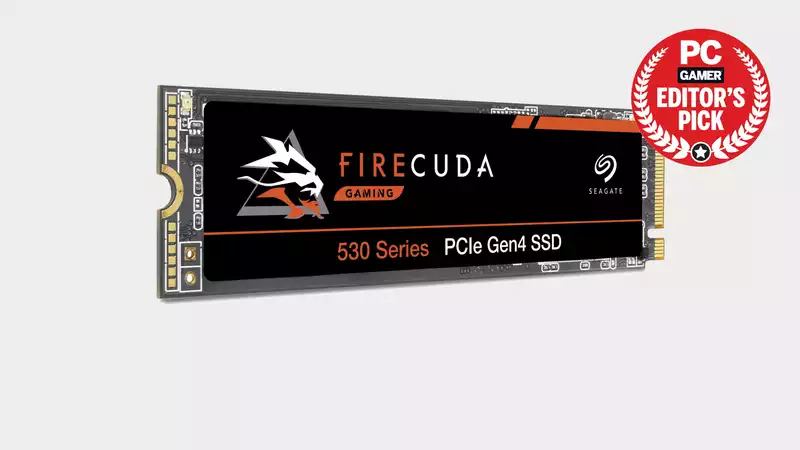For a fast PCIe 4.0 SSD, most enthusiast gamers will likely consider drives from Samsung and Western Digital. Seagate remains a big player in the mechanical HDD market, but I have wondered in the past if Seagate missed a trick by not aggressively entering the SSD market, especially through acquisitions, as its HDD competitor WD has done.
However, it would be dangerous to give up on Seagate.
We eagerly awaited the release of Seagate's FireCuda 530 series of PCIe 4.0 NVMe drives. And we can happily say that the time has come to add Seagate to the list of manufacturers capable of producing top-tier SSDs. Even if you don't read to the conclusion, we can safely tell you that the Seagate FireCuda 530 is at least as good as any SSD on the market.
The Seagate FireCuda 530 2TB is a 2280 (80mm long) M.2 drive. It combines the latest Micron 176-Layer TLC NAND with a Phison PS5018-E18 controller. Micron claims that its 176L TLC NAND is the industry's best, with a 30% smaller die size and 35% better read and write latency than its previous generation 96L NAND
.
The 2TB FireCuda 530 has a rated sequential read/write speed of 7300/6900 MB/sec, pushing the limits of the PCIe 4.0 x4 interface. For other capacities, the 4TB drive has the same rating, while the smaller 1TB and 500GB drives are rated at 7300/6000 MB/sec and 7000/3000 MB/sec respectively.
The FireCuda 530 also comes in two basic versions, one with a heatsink and one without. The one on hand is the version without a heatsink.
However, it is less important for overall aesthetics, as it will most likely be hidden under the motherboard's heatsink.
The other version includes a sturdy, chunky metal heatsink developed in partnership with EKWB. It is very simple. If you want to install it under the motherboard heatsink, buy the standard one; otherwise, buy the EKWB one. However, there is an additional charge for the heat sinks. In fact, there is about a $50 difference between the two 2TB drives, which is quite expensive.
One of the key features of the FireCuda 530 series is its rather impressive endurance rating compared to other PCIe 4.0 drives and Phison E18 drives: the 2TB model has a high endurance rating of 2550TBW and the 4TB has a high endurance rating of 5100TBW. These ratings make the Samsung 980 Pro and WD_Black SN850 look like cheap, inexpensive drives.
Combined with Seagate's excellent data recovery plan, it would be easy for Seagate to repurpose the 530 as a workstation-class product, especially now that the Optane drive has been discontinued. However, Seagate does not support AES 256 encryption. Seagate would undoubtedly say that drive encryption is unnecessary for a "gaming" SSD.
Some SSDs with Phison E18 do not come with any sort of management software, which can be a hindrance if you want to clone an existing drive. Seagate comes with a reskinned version of Acronis True Image that is easy to use. Seagate's SeaTools app also deserves a mention. This app provides S.M.A.R.T. monitoring, health information, self-test, erase capabilities, and more.
Real-World Performance
Synthetic Storage Performance
So what about the performance?" If Seagate wants to sell more expensive drives than the well-established SN850 and 980 Pro, it has to deliver. Modern Phison E18 drives typically excel in sequential read and write tasks, but tend to underperform in random performance, especially random read tasks and IOPS, which are critical for gaming performance.
Barring PCMark 10 storage tests, the FireCuda 530 rivals or surpasses the big bores of the storage world, and when you add its superior sequential performance and endurance ratings, the Seagate 530 is at least as good as any consumer SSD on the market Seagate 530 is at least as good as any consumer SSD on the market.
Peak temperatures were recorded during the test. The drive was run "naked" with a Noctua fan to cool it down; the 2TB FireCuda 530's peak temperature reached 71°C, making it a fairly hot drive, but we did not experience any throttling during our lengthy testing. However, airflow or an effective motherboard heatsink should be used.
We would like to compare both the normal drive and the drive with the EKWB installed, but we would be surprised if there is more than a few degrees difference between the two.
As a major player in the storage industry, one would think that Seagate would have struggled with the decision to hold off on releasing their best SSD until they could make a splash with the 176L NAND. To me, this decision was totally worth it. Class-leading sequential performance and an incredible endurance rating, plus excellent random read and write performance.
These set the Seagate FireCuda 530 apart from the pack. As a great C drive, it can be used to store an extensive game library or as a scratch disk for large data sets that need to be moved frequently. It can handle any workload.
Seagate is aware that it has a strong competitor, which is why prices are skyrocketing. Perhaps too high. In fact, the Seagate 530 2TB appears to be the most expensive of all consumer 2TB SSDs. Combine that with a tremendous endurance rating and great performance, and it's no surprise that the FireCuda 530 is at a premium. But pricing is always volatile, especially in the current climate.
However, Seagate has shaken up the top end of the SSD market. Samsung and WD are now very serious competitors. Buy a Seagate FireCuda 530 and you'll get top-tier performance and reliability ratings that the competition can't match.
.

Comments